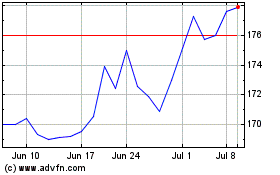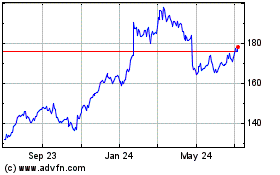Currency Trading: Weak Dollar Gives Boost to U.S. Earnings -- WSJ
April 27 2016 - 3:02AM
Dow Jones News
By Chelsey Dulaney
U.S. corporations have been getting an unexpected boost from the
weak dollar this year. Now all eyes are on the Federal Reserve to
see if that lift can last.
Analysts came into the current earnings season warning that
first-quarter results would fall at their steepest pace in several
years. Instead, 75% of the companies in the S&P 500 that have
reported results for the period beat analysts' earnings forecasts,
according to FactSet, above the past five years' average of
67%.
Dubravko Lakos-Bujas, head of U.S. equity strategy at J.P.
Morgan Chase & Co., said that is due in part to low
expectations heading into the quarter. However, "part of that is
some relief related to the dollar," he said.
The dollar suffered its worst quarterly performance since 2010,
falling 4.2% in the quarter as the Fed signaled it could take a
slower approach to raising short-term interest rates because of
concerns about the global economy.
When the Fed concludes its latest policy meeting Wednesday, any
sign the central bank thinks the economy is firm enough to weather
a rate rise could strengthen the dollar. That could crimp results
at U.S. multinationals, because it diminishes the value of their
overseas sales when translated back into U.S. currency, and makes
their exports less competitive.
The dollar's strength in recent quarters has hurt Delta Air
Lines Inc. by depressing the value of its overseas tickets and
weighing on demand in regions like Latin America and Eastern
Europe. Now a weaker dollar is providing Delta some relief.
"One positive is that we will get a big help from currency as it
turns from a headwind into a tailwind beginning in the next
quarter," Delta Chief Revenue Officer Glen Hauenstein said on a
conference call April 14.
Also seeing relief is International Business Machines Corp. Its
4.6% decline in first-quarter revenue could have been worse, except
that the damage from currency translation was about $90 million
less than it had forecast, IBM said earlier this month.
Chief Financial Officer Martin Schroeter said on a conference
call that IBM's profit would get a boost from currency conversion
if the dollar remains at current levels for the rest of the
year.
If the dollar remains weak, he said, "we'd do a little bit
better at this point in profit."
Procter & Gamble Co. and Microsoft Corp. also were among the
more than a dozen companies that said they are benefiting or expect
to benefit from a weaker greenback.
The risk now is the benefits could easily be reversed by
changing market perceptions of what central banks are likely to
do.
Many company executives are hesitant to factor a weakening
dollar into their outlooks.
PepsiCo Inc., for example, didn't change its profit forecast for
the year after its better-than-expected first quarter and still
thinks its revenue and profit will take a 4% haircut due to
currency moves.
A Pepsi spokesman declined to comment, but executives noted on a
conference call last week that Pepsi uses analyst projections for
currency rather than current spot rates.
Other companies, however, have proved more willing to reflect a
weaker dollar in their forecasts. Cigarette maker Philip Morris
International Inc. and pharmaceutical giant Johnson & Johnson
boosted their guidance, citing easing currency headwinds.
Toy maker Hasbro Inc. and Netflix Inc. also indicated that they
could benefit from favorable currency movements starting as soon as
the current quarter.
"Last year we had a lot of headwinds, especially on the
international revenue line," said Netflix CFO David Wells on an
earnings call last week. "This year we're seeing the reverse of
that with the weakening of the dollar at least in the first part of
the year here where our international contribution margin is
benefiting from that."
The dollar started its climb in mid-2014, as the Federal Reserve
began to unwind its stimulus program and markets became more
optimistic that the central bank would raise short-term interest
rates for the first time since 2006.
But the strength and speed of the dollar's appreciation caught
many companies by surprise. Though some of them hedged currency
risks with derivative contracts that allow them to lock in an
exchange rate in advance, programs weren't aggressive enough to
fully protect U.S. multinationals from the dollar's rise.
The final months of 2015 were especially painful: A record 45%
of U.S. companies reported a negative currency impact in the fourth
quarter, according to FiREapps, a foreign-exchange software
company.
U.S. companies had been bracing for a particularly tough first
quarter. Analysts estimate an 8.8% decline in first-quarter
earnings for S&P 500 companies, according to FactSet, which
would mark the biggest year-over-year decline since 2009. Still, it
would represent an improvement from the 9.4% decline analysts had
forecast when earnings season began in early April.
Though the dollar was stronger in the first quarter than it was
a year ago, which hurt year-over-year growth numbers, many analysts
and companies had expected a bigger hit than materialized.
(END) Dow Jones Newswires
April 27, 2016 02:47 ET (06:47 GMT)
Copyright (c) 2016 Dow Jones & Company, Inc.
International Business M... (NYSE:IBM)
Historical Stock Chart
From Mar 2024 to Apr 2024

International Business M... (NYSE:IBM)
Historical Stock Chart
From Apr 2023 to Apr 2024
